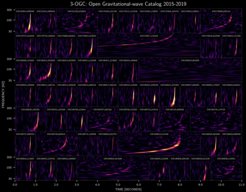An open gravitational-wave catalog v3.0
Research team led by AEI scientists publishes independent analysis of public LIGO/Virgo data and finds 57 gravitational-wave signals, 4 of which are new discoveries
Researchers from the Max Planck Institute for Gravitational Physics (Albert Einstein Institute; AEI) in Hannover together with an international colleague have published their third Open Gravitational-wave Catalog (3-OGC) based on LIGO/Virgo data from the O1, O2, and O3a observing runs. Not only do they confirm the 50 binary black hole mergers and 2 binary neutron star mergers published by the LIGO and Virgo collaborations, they also find 5 additional black hole merger candidates. Four of them are new discoveries not previously reported elsewhere. This emphasises the value of independent analyses of public LIGO/Virgo data with new methods. The research team makes available its comprehensive catalog of 57 signals and sub-threshold candidates from O1, O2, and O3a.
Paper abstract
We present the third Open Gravitational-wave Catalog (3-OGC) of compact-binary coalescences, based on the analysis of the public LIGO and Virgo data from 2015 through 2019 (O1, O2, O3a). Our updated catalog includes a population of 57 observations, including four binary black hole mergers that had not previously been reported. This consists of 55 binary black hole mergers and the two binary neutron star mergers GW170817 and GW190425. We find no additional significant binary neutron star or neutron star--black hole merger events. The most confident new detection is the binary black hole merger GW190925_232845 which was observed by the LIGO Hanford and Virgo observatories with Pastro>0.99; its primary and secondary component masses are 20.2+3.9−2.5M⊙ and 15.6+2.1−2.6M⊙, respectively. We estimate the parameters of all binary black hole events using an up-to-date waveform model that includes both sub-dominant harmonics and precession effects. To enable deep follow-up as our understanding of the underlying populations evolves, we make available our comprehensive catalog of events, including the sub-threshold population of candidates, and the posterior samples of our source parameter estimates.













